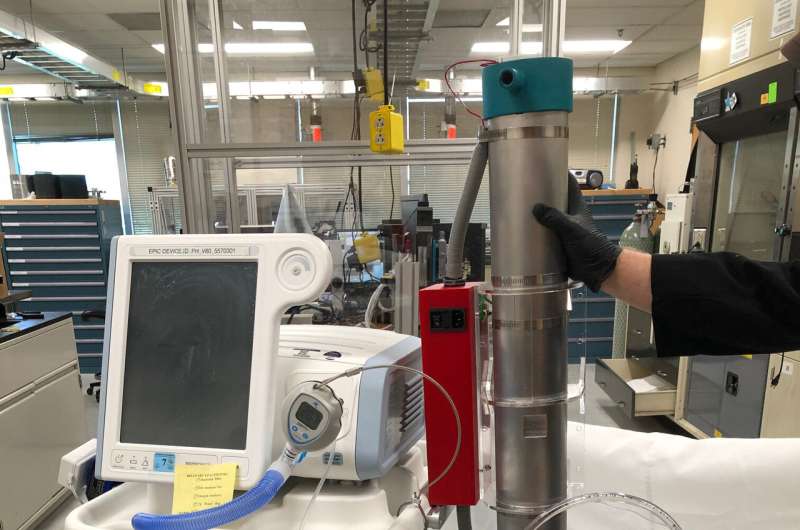Converted medical tool kits increase breathing machines available for COVID-19 treatment

In less than a month, Sandia National Laboratories converted 100 respiratory machines New Mexico hospitals already had on hand into machines that can safely be used as ventilators to help treat patients with severe cases of COVID-19.
Non-invasive ventilators that use masks instead of tubes, BiPAP and CPAP machines, cannot normally be used to treat patients with COVID-19 because they expel a patient's breath into the room, contaminating the area with virus droplets and putting medical staff at risk of exposure.
So, a team of Sandia researchers developed pathogen management kits. The kits can be attached to respiratory machines and use ultraviolet light to disable COVID-19 and other pathogens before a patient's exhaled breath is circulated back into the hospital room.
"Our local hospitals told us that they need solutions now," said project lead and senior manager Ryan Haggerty. "Based on conservative models of ventilator availability in Albuquerque during this pandemic, there will not be enough ventilators to meet the projected need. We are trying to address the gap between now and when large companies that are producing high-end ventilators will be ready to ship machines to hospitals."
Sandia partnered with Presbyterian Healthcare Services and the University of New Mexico Hospital to make sure the team was working to best meet the needs of local hospitals. The hospitals provided information about the type and amount of equipment they had available for conversion and what modifications would be most helpful for safely treating patients with COVID-19.
The project progressed from the idea phase to design, testing and validation within about three weeks. After a prototype of the kit was built and attached to a non-invasive ventilator, the team conducted biological and aerosol testing to ensure the design was safe and effective.
Sandia is ready to deliver its first round of pathogen management kits for non-invasive ventilators for distribution to hospitals like Presbyterian and the UNM Hospital, effectively increasing New Mexico's ventilator count by 100.
The team plans to transfer the pathogen management kit technology through a Cooperative Research and Development Agreement to a regional manufacturer to increase the production rate substantially.
The team also is designing an alarm system that can be added to any ventilator to help keep patients safe when non-standard equipment is being used and will help relieve some of the stress of a high patient-to-medical-care-worker ratio by alerting healthcare workers to any problems.
"This approach can be used to help many other hospitals in New Mexico and throughout the country," Haggerty said. "We are working to transfer the technology to industry to make the systems more broadly available."
Haggerty said that he has had plenty of Sandia researchers and engineers wanting to work on this project. His team has been grateful to use their scientific and engineering expertise to be able to contribute in a meaningful way to help the public during the pandemic.
"Thanks to the team's hard work, Sandia is able to provide significant relief and help keep our medical workers safe," Haggerty said.















